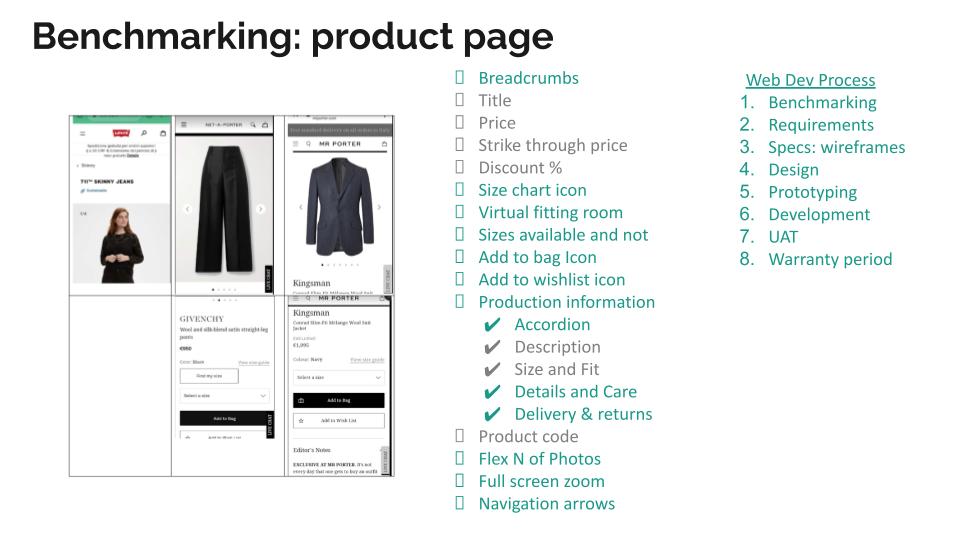Benchmarking is a strategic tool that helps fashion companies evaluate and improve their performance by comparing their processes, products, or services against industry competitors or best practices.
In this article, learn how benchmarking can benefit fashion companies, the steps to take to carry out a benchmark and the best tools to use.
Read on to find out how benchmarking can benefit fashion companies.
Article written with the help of ChatGPT
Identifying industry trends
Benchmarking allows fashion companies to stay updated on the latest industry trends, including consumer preferences, design aesthetics, materials, technology, and marketing strategies. By comparing their offerings to industry leaders, they can identify areas where they need to adapt or innovate to remain competitive.
Improving operational efficiency
Benchmarking helps fashion companies assess their operational processes, such as manufacturing, supply chain management, inventory management, and distribution. By comparing their performance metrics, such as lead times, production costs, or order fulfillment rates, against those of top-performing competitors, they can identify inefficiencies and implement improvements to enhance their operational efficiency.
Enhancing product quality and innovation
By benchmarking their products against those of leading fashion brands, companies can evaluate the quality, design, functionality, and features of their offerings. This analysis can inspire innovation and help identify areas for improvement to meet or exceed customer expectations.
Optimizing pricing strategies
Benchmarking pricing strategies is essential for fashion companies to ensure they remain competitive while maximizing profitability. By comparing their pricing structures, discounts, promotions, and value propositions against industry peers, they can adjust their pricing strategies accordingly.
Strengthening marketing and branding efforts
Benchmarking allows fashion companies to evaluate their marketing and branding activities against those of successful competitors. By examining elements like advertising campaigns, social media presence, influencer partnerships, and customer engagement, companies can identify effective strategies to enhance their own marketing and branding efforts.
Enhancing customer experience
Benchmarking helps fashion companies understand how they fare in terms of customer service, delivery speed, return policies, and overall customer satisfaction. By studying industry leaders and customer feedback, companies can identify opportunities to improve their customer experience, build stronger relationships, and foster loyalty.
Fostering innovation and creativity
Benchmarking encourages fashion companies to look beyond their industry and explore practices and ideas from other sectors. By benchmarking against innovative companies outside the fashion industry, they can gain fresh insights and ideas to foster innovation and creative thinking within their own organization.
It’s important to note that while benchmarking provides valuable insights, fashion companies must also consider their unique market positioning, brand identity, and target audience to make informed decisions and tailor strategies to their specific needs and goals.

Steps to Follow to carry out a Benchmark
To conduct a benchmark analysis for your fashion company, you can follow these steps:
Define the objective: Determine the specific aspect of your business that you want to benchmark. It could be product quality, operational efficiency, marketing strategies, customer service, or any other area that you wish to evaluate and improve.
Identify benchmarking criteria: Determine the key performance indicators (KPIs) or criteria that will be used to evaluate and compare your company’s performance. These could include metrics like sales revenue, production costs, customer satisfaction ratings, delivery times, or social media engagement, depending on the objective of your benchmarking analysis.
Select benchmarking targets: Identify the companies or organizations that are considered industry leaders or have achieved excellence in the area you are benchmarking. These can be direct competitors or companies from other sectors known for their best practices.
Collect data: Gather relevant data and information about your own company’s performance and the performance of the benchmarking targets. This can include financial reports, operational data, customer feedback, market research, and any other data sources that provide insights into the chosen criteria.
Analyze and compare data: Analyze the collected data to compare your company’s performance against the benchmarking targets. Look for gaps, differences, and areas where improvements can be made. Identify both strengths and weaknesses in your own operations.
Identify best practices: Study the practices, strategies, and processes employed by the benchmarking targets that contribute to their success. Look for innovative approaches, effective techniques, and lessons that can be learned and adapted to your own company.
Set improvement goals: Based on the findings from the benchmarking analysis, set specific goals and targets for improvement in the areas identified. These goals should be realistic, measurable, and aligned with your overall business objectives.
Implement changes and monitor progress: Develop and implement action plans to address the identified areas for improvement. Monitor the progress regularly and track the impact of the changes made. Adjust strategies as needed and continue to measure performance against the benchmarks.
Continuous benchmarking: Benchmarking should be an ongoing process to stay relevant and competitive in the fast-paced fashion industry. Regularly revisit your benchmarks, update your criteria, and identify new targets to ensure continuous improvement and innovation.
Remember that benchmarking is most effective when it is tailored to your specific business needs and objectives. Adapt the process to fit your unique circumstances and always consider the broader context and industry trends when interpreting benchmarking results.
Which tools can I use to create a benchmark?
There are several tools you can utilize to create a benchmark for your fashion company. Here are some commonly used tools and approaches:
Key Performance Indicators (KPIs): KPIs are measurable metrics that help you evaluate the performance of your fashion company. Identify relevant KPIs based on your benchmarking objectives. For example, you might track sales revenue, customer acquisition costs, production cycle time, return rates, social media engagement, or customer satisfaction ratings.
Financial Analysis Tools: Financial analysis tools like accounting software or spreadsheets can help you gather and analyze financial data. They allow you to compare and benchmark your company’s financial performance against competitors or industry averages. Examples of financial analysis tools include QuickBooks, Excel, or specialized accounting software.
Survey and Feedback Tools: To gather customer feedback and measure customer satisfaction, you can use survey tools such as SurveyMonkey, Google Forms, or Typeform. Design surveys to collect information on customer preferences, experiences, and satisfaction levels. Compare the results with industry benchmarks or competitors’ feedback to gauge your performance.
Social Media Analytics Tools: If you want to benchmark your social media presence and engagement, social media analytics tools can be useful. Platforms like Facebook Insights, Instagram Insights, or Twitter Analytics provide valuable data on metrics such as reach, engagement, follower growth, and demographics. Compare your performance against industry leaders or competitors’ social media metrics.
Market Research Tools: Market research tools can help you gather insights on industry trends, customer behavior, and competitor analysis. Tools like Nielsen, Euromonitor, or Statista provide market research reports, industry analysis, and consumer behavior data that can be used to benchmark your fashion company’s performance against industry standards.
Operations and Efficiency Analysis Tools: To benchmark operational processes and efficiency, you can utilize tools like process mapping software, supply chain management software, or enterprise resource planning (ERP) systems. These tools help you document and analyze your company’s operations, identify bottlenecks, and compare your performance against industry best practices.
Competitor Analysis Tools: Various tools can assist you in conducting competitor analysis and benchmarking. Tools like SEMrush, SimilarWeb, or Ahrefs provide insights into competitors’ website traffic, search engine rankings, keywords, and online marketing strategies. This information can help you evaluate your online presence and performance against industry leaders.
Internal Data Analysis Tools: Utilize data analytics software like Excel, Google Analytics, or specialized business intelligence tools to analyze your internal data. By examining historical data, sales reports, customer data, or production metrics, you can identify patterns, trends, and areas for improvement. Compare your performance over time to create internal benchmarks.
Remember, the choice of tools depends on the specific areas you want to benchmark and the data you need to collect. It’s important to select tools that align with your objectives, budget, and data requirements. Additionally, consider consulting with experts or hiring professionals if you require specialized tools or expertise for in-depth benchmarking analysis.
